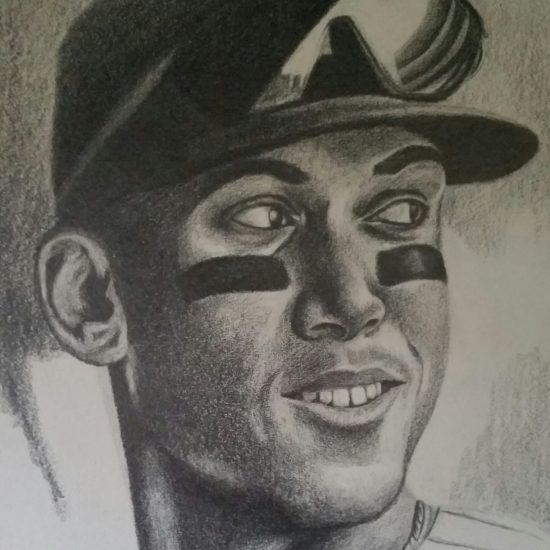This past offseason, Pitcher List introduced Pitch Level Value, or PLV, a new metric that assesses player performance by grading outcomes on the single pitch level. If you’re new to it, you can read Nick Pollack’s primer on PLV here.
You’ll find the definitions below. Grades are on a 20-80 scale.
Swing Aggression: How much more often a hitter swings at pitches, given the swing likelihoods of the pitches they face.
Strikezone Judgement: The “correctness” of a hitter’s swings and takes, using the likelihood of a pitch being a called strike (for swings) or a ball/HBP (for takes).
Decision Value (DV): Modeled value (runs per 100 pitches) of a hitter’s decision to swing or take, minus the modeled value of the alternative.
Contact Ability: A hitter’s ability to make contact (foul strike or BIP), above the contact expectation for each pitch.
Power: Modeled number of extra bases (xISO on contact) above a pitch’s expectation, for each BBE.
Hitter Performance (HP): Runs added per 100 pitches seen by the hitter (including swing/take decisions), after accounting for pitch quality.
Pitch Level Value (PLV): Estimated value of all pitches, based on the predicted outcome of those pitches (0-10, 5 is league average).
Pitch Level Average (PLA): Value of all pitches (ERA Scale), using IP and the total predicted run value of pitches thrown.
Pitch type PLA: Value of a given pitch type (ERA scale), using total predicted run values and an IP proxy for that pitch type (pitch usage % x Total IP).
(Note: All PLV data is current through Thursday, 6/22).
Hitter Performance
We’ll start this week by surveying the top hitters by Hitter Performance (HP) with a minimum of 400 pitches.
Aaron Judge (80 HP: 907 pitches)
Corey Seager (80 HP: 700 pitches)
After a hamstring strain cost him about a month, Seager has been brilliant; His 1.066 OPS over the last 30 days (25 games) trails only Shohei Ohtani and Ryan McMahon among qualifiers. He also has a 195 wRC+ during that span (2nd). Compared to last season, Seager still has elite SZ Judgement (70) but is grading out better in contact (50 to 55) and power (60 to 65).
Luis Arraez (75 HP: 1,076 pitches)
Shohei Ohtani (75 HP: 1,316 pitches)
Nolan Jones (75 HP: 440 pitches)
Luis Arraez continues to be this generation’s Tony Gwynn. Interestingly, his grades in SZ Judgement (50 to 40) and Decision Value (50 to 40) are down relative to last year. He’s also shown less power (45 to 40).
Shohei Ohtani leads all qualifiers with a .993 OPS and is third in strikeouts with 117. He also has a .475 ISO over his last 26 games. Nothing to see here.
Colorado rookie Nolan Jones is excelling so far with terrific power (75), but his SZ Judgement (40) and contact (40) might catch up to him. The sample size is small right now, so he’ll be worth watching.
Corbin Carroll (70 HP: 1,154 pitches)
Freddie Freeman (70 HP: 1,281 pitches)
Luke Raley (70 HP: 721 pitches)
Corbin Carroll’s power was at least one minor question heading into this season, but 16 home runs in 299 PA pretty much answers it; His power rates out above average (55).
Luke Raley probably doesn’t get mentioned as much as he should, given that he’s in a platoon role. Still, he leads the Rays with a .936 OPS. He’s demonstrated elite power (75) and an impressive eye with a 65 in SZ Judgement. His contact grade (30) is the only blemish.
Ryan O’Hearn (70 HP: 401 pitches)
Ronald Acuña Jr. (70 HP: 1,302 pitches)
Sean Murphy (70 HP: 913 pitches)
Christopher Morel (70 HP: 502 pitches)
Where else would you expect to see Ryan O’Hearn and Ronald Acuña Jr. mentioned in the same space? In all seriousness, O’Hearn has impressed with power (65) and above-average contact (55). He’s also shown an impressive eye with a 60 in SZ Judgement. Like Jones, the sample size is small, so we’ll see if he can keep it up, but so far, so good.
Sean Murphy has been brilliant in his first season in Atlanta and leads all catchers with a .915 OPS. It looks like he’s traded in some contact (55 to 45) for a big bump in power (55 to 70). He has also improved in SZ Judgement (55 to 60) and DV (55 to 60).
You know the drill with Christopher Morel; breathtaking power (70), but his contact ability (35) is a weakness. Relative to last year, he’s shown higher swing aggression (0.9% to 3.1%) and a small improvement in SZ Judgement (55 to 60). He has the same grade in DV (55) as last year. But credit to Scott Chu, who pointed this out on Twitter.
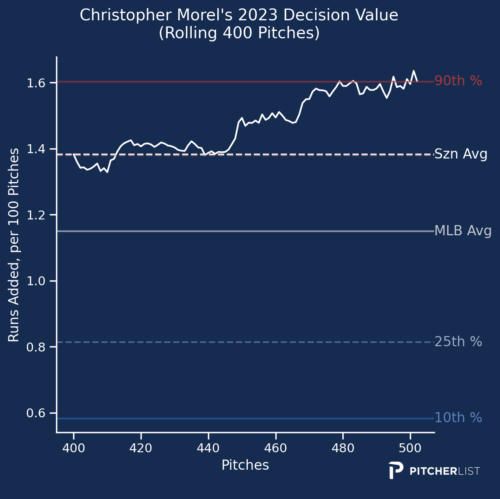
Does it stick? I don’t know, but this is at least an encouraging observation from a young hitter.
Yordan Alvarez (70 HP: 963 pitches)
Yandy Díaz (70 HP: 1,063 pitches)
Ezequiel Duran (70 HP: 746 pitches)
Do you remember the Yandy Díaz home run parade from earlier this season? I do too. Hey, it was fun while it lasted. Despite the dip, Yandy’s power (50) still grades significantly better than last year (40).
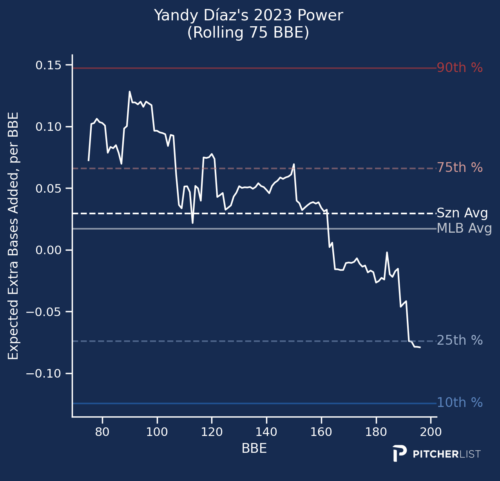
Ezequiel Duran has been a surprise, with a .873 OPS that has added firepower to an already potent Rangers lineup. He has average contact ability (50) and good power (60). However, SZ Judgement (40) and DV (35) are weaknesses, so this might be a sell-high point.
Crawford (730 pitches) had a solid start this past Tuesday, holding the Twins scoreless through five. He’s not fully stretched out yet (77 pitches), but his grades have been impressive, most notably a fastball PLA of 1.73 that leads all pitchers with at least 400 pitches thrown. The results were there in his last start as the heater returned a 39% CSW. The question is can his secondaries support him enough? His slider has also returned an impressive 1.80 PLA, but it’s not a pitch he throws often (8%), so it could be a sample size blip. For more on Crawford, check out Jack Foley’s Going Deep article from earlier this year.
After hitting .232 with a .662 OPS through May, Ward has started showing signs of life. Ward’s DV (70) stood out last year but hasn’t graded out as strongly this season (55). However, he might very well be on to something.
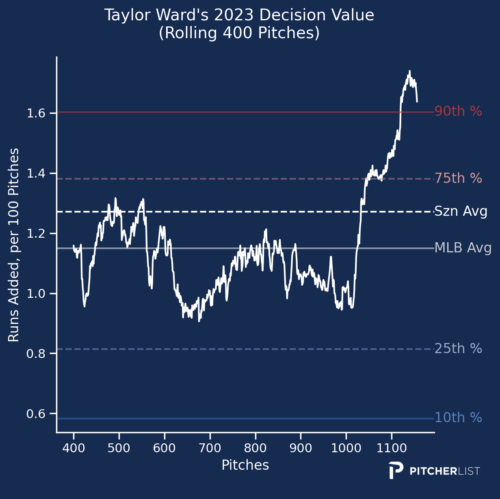
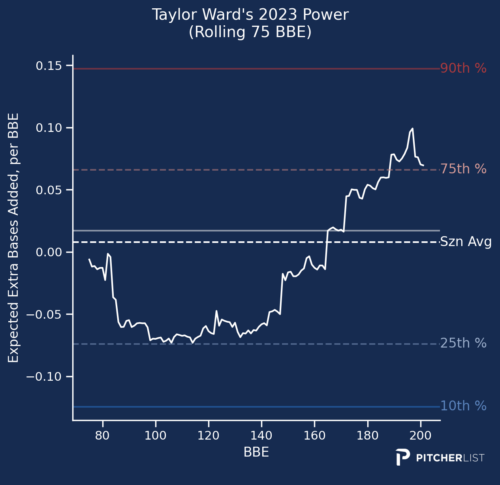
Verlander’s (856 pitches) K rate is down to a career-low 20.5%, and we’ve seen a big drop in his fastball. Last year, the heater had a 2.58 PLA; This year, it’s returned a 4.21 PLA. You can see his fastball’s PLV distributions below; It’s trended more toward the league average this year.
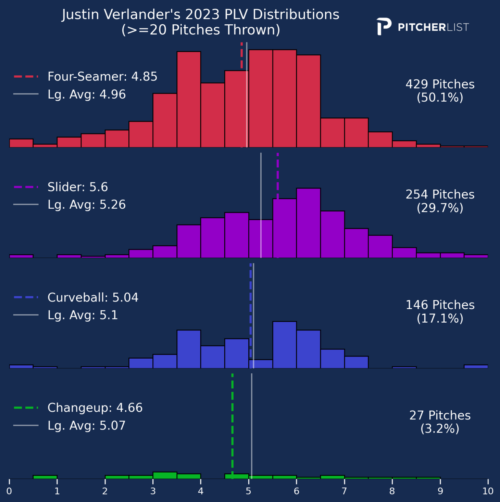
But his slider has graded out better this year, with a 2.07 PLA compared to a 2.61 PLA last year.
Whitlock (715 pitches) has been remarkable since returning from the IL in late April with an elbow injury. This past Tuesday, he needed only 88 pitches to breeze through seven innings against the Twins. Despite allowing four earned runs, it was his best start of the year with a 5.48 PLV. His changeup’s 1.59 PLA trails only Michael Wacha (1.19) and Lucas Giolito (1.49) among starters with at least 800 pitches thrown.
I’m not sure how solidified the closer situation is in Detroit, but Alex Lange’s walk rate of 12.8% is at least a little scary. So there might be a window for Jason Foley (495 pitches). He doesn’t have a great K rate, but he has a low walk rate (5.5%), and his sinker has been terrific with a 1.77 PLA — fifth-best among all pitchers with at least 400 pitches thrown.
Like Yandy Díaz, Chapman got off to a quick start with a 1.152 OPS in April, but his results have cratered since then.

However, the quality of his swings and takes has risen lately (below). Overall, Chapman’s power (65), DV (60), and SZ Judgement (60) rate well above average. So, this could make for a buy-low opportunity.

Pérez’s latest start was a gem; He needed only 80 pitches to hold the Jays off the board through six innings. Overall, the performance earned a terrific 5.62 PLV — the best of his eight starts so far. His fastball has been terrific, earning a 2.68 PLA. But I’m interested to see if he’s starting to get a feel for the slider, too; In that start against the Jays, the slider (27 pitches) recorded a 1.89 PLA, by far its best showing all year.
It’s probably fair to say that the Mets have found themselves relying on Tommy Pham much more than they thought they would. Either way, he’s responded to the challenge well and has led the Mets with a .843 OPS over the last 15 days (11 games). Pham’s (656 pitches) profile is solid overall, with his contact ability (50) being the low point. He’s shown above-average power (60) and still has a good eye at the plate with a 55 in DV and Strikezone Judgement.
Photo by Peter Joneleit/Icon Sportswire | Adapted by Justin Paradis (@JustParaDesigns on Twitter

